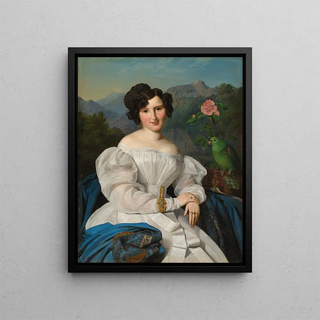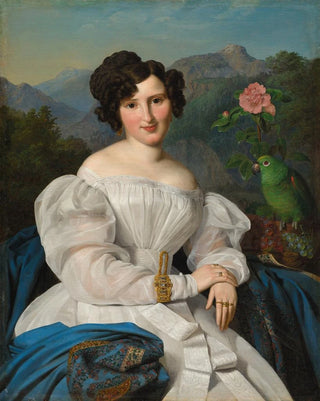Art print Countess Széchenyi - Ferdinand Georg Waldmüller | Art print


View from behind

Frame (optional)
The "Countess Széchenyi" art print by Ferdinand Georg Waldmüller is much more than a simple depiction of a 19th-century aristocrat. It embodies an era where art and social life intertwine, revealing the subtleties of Austrian high society. In this work, Waldmüller manages to capture not only the face of the countess but also the very essence of her character. The penetrating gaze of the countess, combined with the delicacy of the details, invites the viewer to immerse themselves in a universe of refinement and sophistication. This art print is a vivid testament to a bygone era, while remaining surprisingly modern.
Style and uniqueness of the piece
Waldmüller stands out for his realistic approach, which highlights the psychology of the characters he depicts. In "Countess Széchenyi," light plays a crucial role, illuminating the countess's face and creating a striking contrast with the darker background. Textures, whether of her rich fabrics or the details of her jewelry, are rendered with precision that demonstrates the artist's technical skill. Every element of the composition is carefully considered, from the graceful posture of the countess to the delicacy of the surrounding flowers, symbols of beauty and fragility. This painting is a true ode to femininity, where each brushstroke seems to whisper a story.
The artist and his influence
Ferdinand Georg Waldmüller, an emblematic figure of Austrian Romanticism, established himself as one of the most influential painters of his time. Born in 1793, he evolved within a rapidly changing artistic context, where realism and introspection took precedence over academic conventions. Waldmüller captured the human soul with rare sensitivity, making him a precursor of modern art. His portraits, notably that of the Countess Széchenyi, reflect a deep understanding of human emotions. His style has inspired many subsequent artists, cementing his place in art history.

Matte finish

View from behind

Frame (optional)
The "Countess Széchenyi" art print by Ferdinand Georg Waldmüller is much more than a simple depiction of a 19th-century aristocrat. It embodies an era where art and social life intertwine, revealing the subtleties of Austrian high society. In this work, Waldmüller manages to capture not only the face of the countess but also the very essence of her character. The penetrating gaze of the countess, combined with the delicacy of the details, invites the viewer to immerse themselves in a universe of refinement and sophistication. This art print is a vivid testament to a bygone era, while remaining surprisingly modern.
Style and uniqueness of the piece
Waldmüller stands out for his realistic approach, which highlights the psychology of the characters he depicts. In "Countess Széchenyi," light plays a crucial role, illuminating the countess's face and creating a striking contrast with the darker background. Textures, whether of her rich fabrics or the details of her jewelry, are rendered with precision that demonstrates the artist's technical skill. Every element of the composition is carefully considered, from the graceful posture of the countess to the delicacy of the surrounding flowers, symbols of beauty and fragility. This painting is a true ode to femininity, where each brushstroke seems to whisper a story.
The artist and his influence
Ferdinand Georg Waldmüller, an emblematic figure of Austrian Romanticism, established himself as one of the most influential painters of his time. Born in 1793, he evolved within a rapidly changing artistic context, where realism and introspection took precedence over academic conventions. Waldmüller captured the human soul with rare sensitivity, making him a precursor of modern art. His portraits, notably that of the Countess Széchenyi, reflect a deep understanding of human emotions. His style has inspired many subsequent artists, cementing his place in art history.
12,34 €






